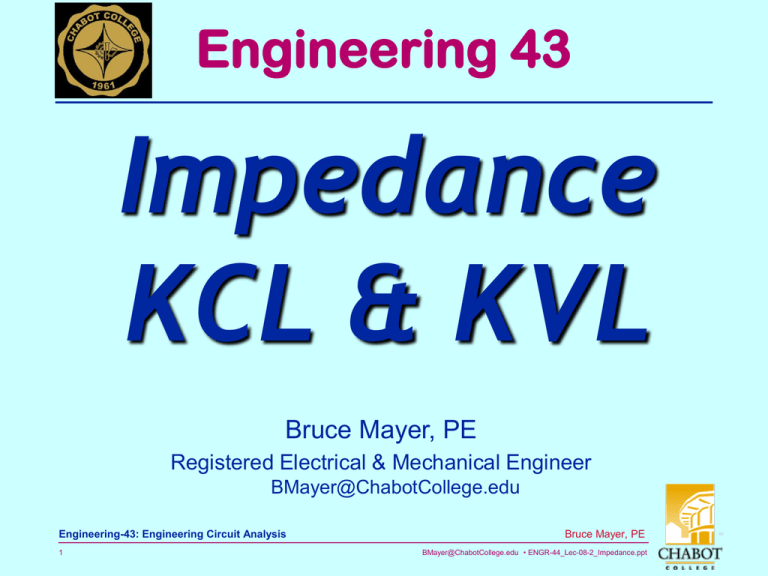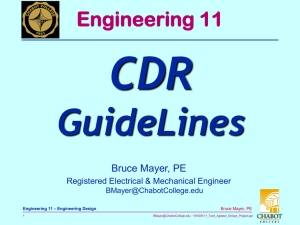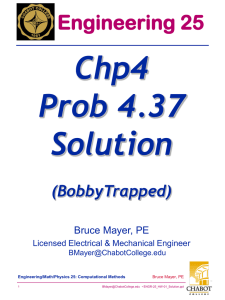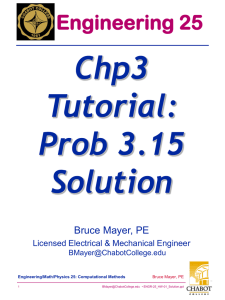Impedance KCL & KVL Engineering 43 Bruce Mayer, PE
advertisement

Engineering 43 Impedance KCL & KVL Bruce Mayer, PE Registered Electrical & Mechanical Engineer BMayer@ChabotCollege.edu Engineering-43: Engineering Circuit Analysis 1 Bruce Mayer, PE BMayer@ChabotCollege.edu • ENGR-44_Lec-08-2_Impedance.ppt Review → V-I in Phasor Space Resistors No Phase Shift V I R Inductors i(t) LAGS V I 90 L Capacitors i(t) LEADS I CV90 Engineering-43: Engineering Circuit Analysis 2 Bruce Mayer, PE BMayer@ChabotCollege.edu • ENGR-44_Lec-08-2_Impedance.ppt Impedance For each of the passive components, the relationship between the voltage phasor and the current phasor is algebraic (previous sld) Consider now the general case for an arbitrary 2-terminal element The Frequency Domain Analog to Resistance is IMPEDANCE, Z Engineering-43: Engineering Circuit Analysis 3 V Z I Since the Phasors V & I Have units of Volts and Amps, Z has units of OHMS Bruce Mayer, PE BMayer@ChabotCollege.edu • ENGR-44_Lec-08-2_Impedance.ppt Impedance cont. Since V & I are COMPLEX, Then Z is also Complex Z V VM v VM ( v i ) | Z | z I I M i I M Impedance is NOT a Phasor • It’s Magnitude and Phase Do Not Change regardless of the Location within The Circuit Engineering-43: Engineering Circuit Analysis 4 However, Z IS a COMPLEX NUMBER that can be written in polar or Cartesian form. • In general, its value DOES depend on the Sinusoidal frequency Z ( ) R jX ( ) R RESISTive component X ( ) REACTive component • Note that the REACTANCE, X, is a function of ω Bruce Mayer, PE BMayer@ChabotCollege.edu • ENGR-44_Lec-08-2_Impedance.ppt Impedance cont.2 Thus Z z R jX The Magnitude and Phase Z R2 X 2 X z tan 1 R Where R Z cos z X Z sin z Engineering-43: Engineering Circuit Analysis 5 Summary Of PassiveElement Impedance Element R L C Phasor Eq. Impedance V RI ZR V jLI Z jL 1 1 V I Z jC jC Examine ZC 1 j j ZC jC jjC 1C 1 1 ZC j XC C C Bruce Mayer, PE BMayer@ChabotCollege.edu • ENGR-44_Lec-08-2_Impedance.ppt KVL & KCL Hold In Phasor Spc v2 (t ) v1 ( t ) v3 ( t ) KVL: v1(t ) v2 (t ) v3 (t ) 0 vi (t ) VMie j ( t i ) , i 1,2,3 i0 (t ) Similarly for the Sinusoidal Currents ... V1 V2 V3 0 Phasors! V1 V3 Engineering-43: Engineering Circuit Analysis 6 i3 (t ) ik (t ) I Mk e j ( t k ) , k 0,1,2,3 VM 11 VM 2 2 VM 33 0 i2 (t ) KCL : i0 (t ) i1 (t ) i2 (t ) i3 (t ) 0 KVL : (VM 1e j1 VM 2 e j 2 VM 3e j3 )e jt 0 V2 i1 (t ) I 0 I1 I 2 I 3 0 I0 I1 I2 I3 Bruce Mayer, PE BMayer@ChabotCollege.edu • ENGR-44_Lec-08-2_Impedance.ppt Series & Parallel Impedances Impedances (which have units of Ω) Combine as do RESISTANCES • The SERIES Case I V1 V2 Z1 Z2 I Zs Z1 Z2 Z s k Z k • The Parallel Case I Z1 I Z2 V V Engineering-43: Engineering Circuit Analysis 7 Zp Z1Z 2 Z1 Z 2 1 1 k Zp Zk Bruce Mayer, PE BMayer@ChabotCollege.edu • ENGR-44_Lec-08-2_Impedance.ppt Admittance The Frequency Domain Analog of CONDUCTANCE is ADMITTANCE • Admittance is Thus Inverse Impedance 1 Y G jB (Siemens) Z • G CONDUCTance • B SUSCEPTance Find G & B In terms of Resistance, R, and Reactance, X Engineering-43: Engineering Circuit Analysis 8 1 1 Y Z R jX Multiply Denominator by the Complex Conjugate 1 R jX R jX Y 2 R jX R jX R X 2 R G 2 R X2 X B 2 R X2 Note that G & R and X & B are NOT Reciprocals Bruce Mayer, PE BMayer@ChabotCollege.edu • ENGR-44_Lec-08-2_Impedance.ppt Series & Parallel Admittance Admittance Element Phasor Eq. Impedance Summarized R L C V RI V j L I 1 V I j C ZR Z jL Z Admittance 1 Y G R 1 Y j L 1 jC Y j C Admittances (which have units of Siemens) Combine as do CONDUCTANCES The SERIES Case 1 1 Ys k Yk Engineering-43: Engineering Circuit Analysis 9 The PARALLEL Case Yp Yk k Bruce Mayer, PE BMayer@ChabotCollege.edu • ENGR-44_Lec-08-2_Impedance.ppt Complex Numbers in MATLAB MATLAB recognizes complex numbers these in these forms • Rectangular • Exponential Can Use “i” or “j” for √(-1) MATLAB Always returns “i” for √(-1) Sometimes need “*” Engineering-43: Engineering Circuit Analysis 10 >> phiR = 23*pi/180 % 23deg in Rads phiR = 0.4014 >> Z1 = 7 + i*23 % if i or j BEFORE, then need * Z1 = 7.0000 +23.0000i >> Z2 = 11 - 13j Z2 = 11.0000 -13.0000i >> Z3 = 43*exp(j*phiR) % Need * Z3 = 39.5817 +16.8014i >> Z4 = 37*exp(0.61j) Z4 = 30.3270 +21.1961i Bruce Mayer, PE BMayer@ChabotCollege.edu • ENGR-44_Lec-08-2_Impedance.ppt Phasors in MATLAB MATLAB Does NOT Recognize Phasor NOTATION • But it DOES handle Complex Exponentials e.g.: >> phi8 = 17*pi/180 phi8 = 0.2967 >> Z7 = 29*exp(j*phi7) Z7 = 21.2093 -19.7780i >> Z8 = -53*exp(j*phi8) Z8 = -50.6842 -15.4957i >> Zsum = Z7 + Z8 Zsum = -29.4749 -35.2737i Z 7 29 43 >> Zdif = Z7 - Z8 Zdif = 71.8934 - 4.2823i Z8 5317 >> Zprod = Z7*Z8 Zprod = -1.3814e+003 +6.7378e+002i Engineering-43: Engineering Circuit Analysis 11 >> phi7 = -43*pi/180 phi7 = -0.7505 >> Zquo = Z7/Z8 Zquo = -0.2736 + 0.4739i Bruce Mayer, PE BMayer@ChabotCollege.edu • ENGR-44_Lec-08-2_Impedance.ppt Phasors in MATLAB MATLAB Always returns Complex No.s in RECTANGULAR Form Can Recover Magnitude & Phase Using Commands • abs(Z) • angle(Z) Engineering-43: Engineering Circuit Analysis 12 >> Zquo = Z7/Z8 Zquo = -0.2736 + 0.4739i >> Asum = abs(Zsum) Asum = 45.9674 >> phi_sum = angle(Zsum) phi_sum = -2.2669 >> phi_sumd = phi_sum*180/pi phi_sumd = -129.8824 >> Aquo = abs(Zquo) Aquo = 0.5472 >> phi_quo = angle(Zquo) phi_quo = 2.0944 >> phi_quod = phi_quo*180/pi phi_quod = 120.0000 >> Zquo_test = Aquo*exp(j*phi_quo) Zquo_test = -0.2736 + 0.4739i Bruce Mayer, PE BMayer@ChabotCollege.edu • ENGR-44_Lec-08-2_Impedance.ppt MATLAB: a+jb ↔ A∟φ BMayer MATLAB Functions function Zrectd = Rectab(Mag, phi_deg) % B. Mayer 22Apr09 * ENGR43 % finds for POLAR COMPLEX number Z the Rectangular Equivalet %% note that phi is in DEGREES % a = Mag*cosd(phi_deg); b = Mag*sind(phi_deg); Zrectd = a + j*b function Phasor = MagPh(Zr) % B. Mayer 22Apr09 * ENGR43 % finds for RECTANGULAR COMPLEX number Z %% Magnitude %% Phase Angle in DEGREES Magnitude = abs(Zr); Phase_deg = angle(Zr)*180/pi; Phasor = [Magnitude, Phase_deg]; Engineering-43: Engineering Circuit Analysis 13 Example >> Z1r = 13 - 19j Z1r = 13.0000 -19.0000i >> Phasor1 = MagPh(Z1r) Phasor1 = 23.0217 -55.6197 >> Phasor2 = [43 -127] Phasor2 = 43 -127 >> Zr2 = Rectab(Phasor2(1), Phasor2(2)) Zr2 = -25.8780 -34.3413i Bruce Mayer, PE BMayer@ChabotCollege.edu • ENGR-44_Lec-08-2_Impedance.ppt MATLAB Equivalent Functions Rectangular to Polar Polar to Rectangular Both use RADIANS only Engineering-43: Engineering Circuit Analysis 14 Bruce Mayer, PE BMayer@ChabotCollege.edu • ENGR-44_Lec-08-2_Impedance.ppt Phasor Diagrams As Noted Earlier Phasors can be Considered as VECTORS in the Complex Plane • See Diagram at Right Phasors Obey the Rules of Vector Arithmetic • Which were orignially Developed for Force Mechanics Engineering-43: Engineering Circuit Analysis 15 Imaginary b A a Real See Next Slide for Review of Vector Addition • Text Diagrams follow the PARALLELOGRAM Method Bruce Mayer, PE BMayer@ChabotCollege.edu • ENGR-44_Lec-08-2_Impedance.ppt Vector Addition Parallelogram Rule For Vector Addition Examine Top & Bottom of The Parallelogram • Triangle Rule For Vector Addition • Vector Addition is Commutative PQ QP C B C B • Vector Subtraction → Reverse Direction of The Subtrahend P Q P Q Engineering-43: Engineering Circuit Analysis 16 Bruce Mayer, PE BMayer@ChabotCollege.edu • ENGR-44_Lec-08-2_Impedance.ppt Example Phasor Diagram For The Ckt at Right, Draw the Phasor Diagrams as a function of Frequency First Write KCL V V IS jCV R jL 1 1 I S V jC R jL I S V k Yk Admittance s Now we can Select ANY Phasor Quantity, I or V, as the BaseLine Engineering-43: Engineering Circuit Analysis 17 That is, we Can Select ONE Phasor to have a ZERO Phase Angle • In this Case Choose V Next Examine Frequency Sensitivity of the Admittances Bruce Mayer, PE BMayer@ChabotCollege.edu • ENGR-44_Lec-08-2_Impedance.ppt Example Phasor Diagram cont The KCL V V IS jCV R jL This Eqn Shows That as ω increases • YL DEcreases • YC INcreases Now Rewrite KCL using Phasor Notation Examining the Phase Angles Shows that in the Complex Plane • IR Points RIGHT • IL Points DOWN • IC Points UP VM 0 VM 90 IS CVM 90 R L As ω Increases, IC as 1 j 1 90; j 190 begins to dominate IL Engineering-43: Engineering Circuit Analysis 18 Bruce Mayer, PE BMayer@ChabotCollege.edu • ENGR-44_Lec-08-2_Impedance.ppt Example Phasor Diagram cont.2 | I L || I C | Case-I: ω=Med so That • YL YC I C jCV IC I L 0 V IL jL IS IR Case-II: ω=Low so That • YL 2YC The Circuit is Basically INDUCTIVE Engineering-43: Engineering Circuit Analysis 19 Case-III: ω=Hi so That • YC 2YL The Circuit is Basically CAPACITIVE | I L || I C | Bruce Mayer, PE BMayer@ChabotCollege.edu • ENGR-44_Lec-08-2_Impedance.ppt KCL & KVL for AC Analysis Simple-Circuit Analysis • AC Version of Ohm’s Law → V = IZ • Rules for Combining Z and/or Y • KCL & KVL • Current and/or Voltage Dividers More Complex Circuits • Nodal Analysis • Loop or Mesh Analysis • SuperPosition Engineering-43: Engineering Circuit Analysis 20 Bruce Mayer, PE BMayer@ChabotCollege.edu • ENGR-44_Lec-08-2_Impedance.ppt Methods of AC Analysis cont. More Complex Circuits • Thevenin’s Theorem • Norton’s Theorem • Numerical Techniques – MATLAB – SPICE Engineering-43: Engineering Circuit Analysis 21 Bruce Mayer, PE BMayer@ChabotCollege.edu • ENGR-44_Lec-08-2_Impedance.ppt Example For The Ckt At Right, Find VS if Vo 8V45 Solution Plan: GND at Bot, then Find in Order • I3 → V1 → I2 → I1 → VS I3 First by Ohm I3 VO V 445 A 2 Then V1 by Ohm V1 (2 j 2)I 3 8 45 445 Then I2 by Ohm I2 V1 11.314V0 5.657 90( A) j 2 290 Then I1 by KCL I1 I 2 I 3 5.657 90 445 I1 j5.657 (2.828 j 2.828)( A) I1 2.828 j 2.829( A) V1 11.3140(V ) Engineering-43: Engineering Circuit Analysis 22 Bruce Mayer, PE BMayer@ChabotCollege.edu • ENGR-44_Lec-08-2_Impedance.ppt Example cont. Z eq Then VS by Ohm & KVL VS 2I1 V1 2(2.828 j 2.829) 11.3140 VS 16.97 j5.658(V ) VS 17.888V 18.439 Note That we have I1 and VS Thus can find the Circuit’s Equivalent Impedance VS Z eq I1 Engineering-43: Engineering Circuit Analysis 23 Then Zeq 17.888V 18.439 Z eq 2.828 j 2.829A Z eq 4.00 j 2.00 Z eq 4.47226.56 Bruce Mayer, PE BMayer@ChabotCollege.edu • ENGR-44_Lec-08-2_Impedance.ppt Nodal Analysis for AC Circuits For The Ckt at Right Find IO Use Node Analysis • Specifically a SuperNode that Encompasses The V-Src KCL at SN V1 V2 V2 20 0 1 j1 1 1 j1 And the SuperNode Constraint V2 V1 60 or V1 V2 60 Engineering-43: Engineering Circuit Analysis 24 The Relation For IO V2 IO ( A) 1 In SuperNode KCL Sub for V1 V2 60 V 20 V2 2 0 1 j1 1 j1 Bruce Mayer, PE BMayer@ChabotCollege.edu • ENGR-44_Lec-08-2_Impedance.ppt Nodal Analysis cont. Solving for For V2 1 1 6 V2 1 2 1 j 1 1 j 1 1 j1 The Complex Arithmetic V2 (1 j1) (1 j1)(1 j1) (1 j1) 2(1 j1) 6 (1 j1)(1 j1) 1 j1 4 V2 8 j2 1 j V2 Or 8 j 2 1 j 5 j 3 1 4 2 Engineering-43: Engineering Circuit Analysis 25 Recall 2 V2 V IO 1 3 5 I O j ( A) 2 2 I O 2.92 A 30.96 Bruce Mayer, PE BMayer@ChabotCollege.edu • ENGR-44_Lec-08-2_Impedance.ppt Loop Analysis for AC Circuits Same Ckt, But Different Approach to Find IO Note: IO = –I3 Constraint: I1 = –2A0 The Loop Eqns LOOP 2 : (1 j )( I1 I 2 ) 60 (1 j )( I 2 I 3 ) 0 LOOP 3 : (1 j )( I 2 I 3 ) 1I 3 0 Solution is I3 = –IO Recall I1 = –2A0 Engineering-43: Engineering Circuit Analysis 26 Simplify Loop2 & Loop3 L2 : 2 I 2 (1 j ) I 3 6 (1 j ) I1 2 I 2 (1 j ) I 3 6 (1 j )( 2) L3 : (1 j ) I 2 (2 j ) I 3 0 Two Eqns In Two Unknowns Bruce Mayer, PE BMayer@ChabotCollege.edu • ENGR-44_Lec-08-2_Impedance.ppt Loop Analysis cont Isolating I3 (1 j ) 2 2(2 j ) I 3 (1 j )(8 2 j ) I2 Then The Solution I3 10 6 j 4 I0 5 3 j ( A) 2 2 Could also use a SuperMesh to Avoid the Current Source CONSTRAINT : I 2 I1 20 SUPERMESH : (1 j )I1 60 1(I 2 I 3 ) 0 MESH 3 : 1(I 3 I 2 ) (1 j )I 3 0 Engineering-43: Engineering Circuit Analysis 27 The Next Step is to Solve the 3 Eqns for I2 and I3 So Then Note IO I 2 I3 Bruce Mayer, PE BMayer@ChabotCollege.edu • ENGR-44_Lec-08-2_Impedance.ppt Recall Source SuperPosition I I L2 1 L = V 1 L Circuit With Current Source Set To Zero By Linearity IL I I 2 L Engineering-43: Engineering Circuit Analysis 28 VL2 Circuit with Voltage Source set to Zero • OPEN Ckt 1 L + • SHORT Ckt VL V V 1 L 2 L Bruce Mayer, PE BMayer@ChabotCollege.edu • ENGR-44_Lec-08-2_Impedance.ppt AC Ckt Source SuperPosition Same Ckt, But Use Source SuperPosition to Find IO Deactivate V-Source The Reduced Ckt Combine The Parallel (1 j )(1 j ) Impedances Z ' (1 j ) || (1 j ) 1 (1 j ) (1 j ) Engineering-43: Engineering Circuit Analysis 29 Bruce Mayer, PE BMayer@ChabotCollege.edu • ENGR-44_Lec-08-2_Impedance.ppt AC Source SuperPosition cont. Find I-Src Contribution to IO by I-Divider Z ' 1 I '0 20 The V-Src Contribution by V-Divider 1 10( A) 11 Now Deactivate the I-Source (open it) 1 1 j Z " 1 || (1 j ) 1 1 j Engineering-43: Engineering Circuit Analysis 30 Z " 1 || (1 j ) " Z V1" " 60(V ) Z 1 j Z" I V 1 " 60( A) Z 1 j " O " 1 Bruce Mayer, PE BMayer@ChabotCollege.edu • ENGR-44_Lec-08-2_Impedance.ppt AC Source SuperPosition cont.2 Sub for Z” 1 j 2 j " I0 6 ( A) 1 j 1 j 2 j 1 j I 6 (1 j ) 3 j " 0 6 6 I j ( A) 4 4 " 0 Finally SuperPose the Response Components Engineering-43: Engineering Circuit Analysis 31 The Total Response 3 3 I 0 I I 1 2 2 ' 0 " 0 5 3 I 0 j ( A) 2 2 Bruce Mayer, PE BMayer@ChabotCollege.edu • ENGR-44_Lec-08-2_Impedance.ppt j Multiple Frequencies When Sources of Differing FREQUENCIES excite a ckt then we MUST use SuperPosition for every set of sources with NON-EQUAL FREQUENCIES An Example V2 V1 We Can Denote the Sources as Phasors V1 100V0 & V2 50V 10 But canNOT COMBINE them due to DIFFERENT frequencies Engineering-43: Engineering Circuit Analysis 32 Bruce Mayer, PE BMayer@ChabotCollege.edu • ENGR-44_Lec-08-2_Impedance.ppt Multiple Frequencies cont.1 Must Use SuperPosition for EACH Different ω V1 V1 first (ω = 10 r/s) Z L ,10 j 10 1 V2 next (ω = 20 r/s) Z L , 20 j 20 1 The Frequency-1 Domain Phasor-Diagram Engineering-43: Engineering Circuit Analysis 33 Bruce Mayer, PE BMayer@ChabotCollege.edu • ENGR-44_Lec-08-2_Impedance.ppt Multiple Frequencies cont.2 The Frequency-2 Domain Phasor-Diagram V2 Recover the Time Domain Currents Finally SuperPose it i' t i" t 7.07 A cos 10t 45 2.24 A cos 20t 73.43 – Note the MINUS sign from CW-current assumed-Positive Engineering-43: Engineering Circuit Analysis 34 Bruce Mayer, PE BMayer@ChabotCollege.edu • ENGR-44_Lec-08-2_Impedance.ppt Source Transformation Source transformation is a good tool to reduce complexity in a circuit • WHEN IT CAN BE APPLIED “ideal sources” are not good models for real behavior of sources • A real battery does not produce infinite current when short-circuited Resistance → Impedance Analogy ZV + - RV VS a ZI a RI b IS b THE MODELS ARE EQUIVALENT S WHEN ZV Z I Z RV RI R VS RI S VS ZI S Improved model Improved model for voltage source for current source Engineering-43: Engineering Circuit Analysis 35 Bruce Mayer, PE BMayer@ChabotCollege.edu • ENGR-44_Lec-08-2_Impedance.ppt Source Transformation Same Ckt, But Use Source Transformation to Find IO Start With I-Src Then the Reduced Circuit V ' 8 2 j Next Combine the Voltage Sources And Xform Engineering-43: Engineering Circuit Analysis 36 VS' 8 2 j IS Z Series 1 j Bruce Mayer, PE BMayer@ChabotCollege.edu • ENGR-44_Lec-08-2_Impedance.ppt Source Transformation cont The Reduced Ckt Now Combine the Series-Parallel Impedances 1 j 2 Z p (1 j ) || (1 j ) 1 11 j j The Reduced Ckt IO by I-Divider IO I S 8 2 j 1 j Zp 1 4 j 4 j 1 j 2 1 j 1 j 1 j IO 5 j3 2 Engineering-43: Engineering Circuit Analysis 37 IS Bruce Mayer, PE BMayer@ChabotCollege.edu • ENGR-44_Lec-08-2_Impedance.ppt 5 j3 2 WhiteBoard Work Let’s Work This Nice Problem to Find VO Engineering-43: Engineering Circuit Analysis 38 Bruce Mayer, PE BMayer@ChabotCollege.edu • ENGR-44_Lec-08-2_Impedance.ppt All Done for Today Charles Proteus Steinmetz Delveloper of Phasor Analysis Engineering-43: Engineering Circuit Analysis 39 Bruce Mayer, PE BMayer@ChabotCollege.edu • ENGR-44_Lec-08-2_Impedance.ppt Engineering-43: Engineering Circuit Analysis 40 Bruce Mayer, PE BMayer@ChabotCollege.edu • ENGR-44_Lec-08-2_Impedance.ppt Engineering-43: Engineering Circuit Analysis 41 Bruce Mayer, PE BMayer@ChabotCollege.edu • ENGR-44_Lec-08-2_Impedance.ppt WhiteBoard Work Let’s Work this Nice Problem i1 (t) i2 (t) 3.33 F 20 is(t) 6mH 10 iS t 100mA cos5000t 8.13 I 100mA8.13 See Next Slide for Phasor Diagrams Engineering-43: Engineering Circuit Analysis 42 Bruce Mayer, PE BMayer@ChabotCollege.edu • ENGR-44_Lec-08-2_Impedance.ppt P8.29 Phasor Diagrams Tip-To-Tail Phasor (Vector) Addition I 2 84.98mA109.44 I S 99.8mA8.11 I S 100mA8.13 I 2 84.98mA109.44 I1 143.3mA 27.41 I1 143.3mA 27.41 Engineering-43: Engineering Circuit Analysis 43 Bruce Mayer, PE BMayer@ChabotCollege.edu • ENGR-44_Lec-08-2_Impedance.ppt WhiteBoard Work Let’s Work Some Phasor Problems 2 z 4 10mH Engineering-43: Engineering Circuit Analysis 44 500F Bruce Mayer, PE BMayer@ChabotCollege.edu • ENGR-44_Lec-08-2_Impedance.ppt







